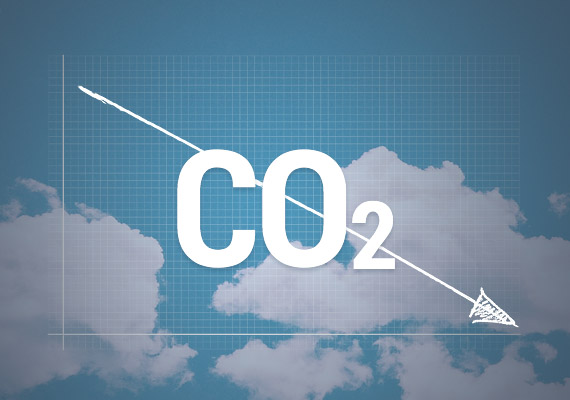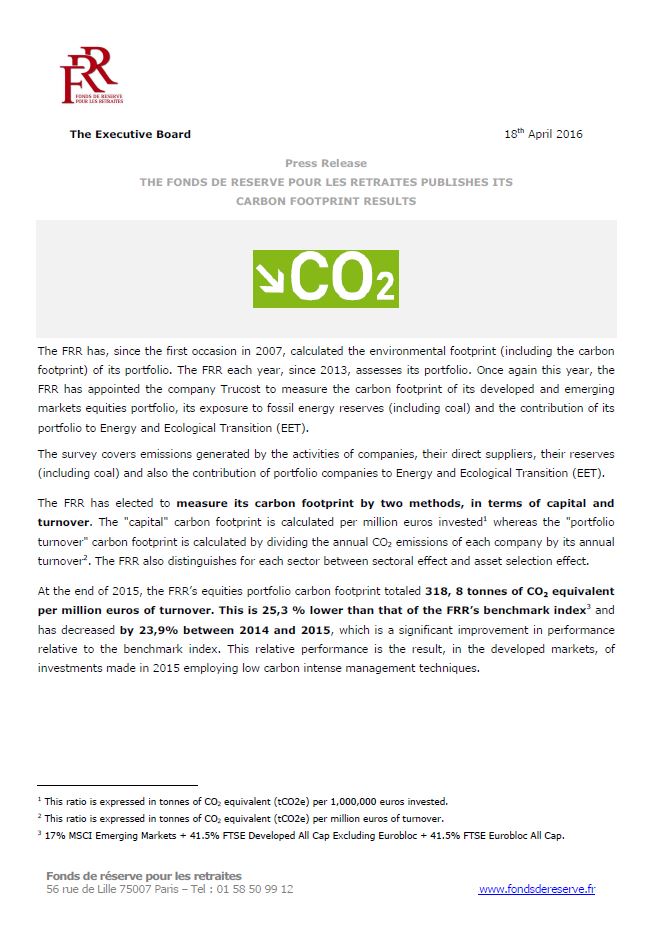The FRR and Climate Change
Since its establishment, the challenges of climate change have been integral to the FRR’s investment strategy. Today, once again, the FRR reaffirms its commitment by gradually reducing its exposure to CO2 emissions and fossil fuel reserves.
For now, faced with a lack of consensus on how to assess the carbon footprint of a portfolio, the FRR has not set overall fixed targets in terms of its decarbonisation efforts.

Like the vast majority of investors, the FRR does not in principle exclude any particular sectors. It strives towards decreasing the overall carbon footprint of its portfolio by assessing risk and orienting its investments ever increasingly towards ecological and energy transition (EET). The reduction of its carbon footprint is measured comparatively against benchmark indices.
The FRR has for several years voluntarily signed up to various international commitments to promote good practice amongst institutional investors and encourage the most polluting businesses to reduce their negative impact on the environment in whichever sector they may operate.
The FRR is taking the following actions:
- Measuring its carbon footprint and the exposure of its portfolios to fossil fuel reserves.
- Reducing the carbon footprint (emissions and fossil fuel reserves) of its portfolios and therefore the associated carbon risk.
- Investing in renewable energy and innovative technologies.
- Pursuing dialogue with institutional investors and issuers as part of a policy of engagement centered around existing collaborative initiatives (PRI, IIGCC, …).
- Encouraging issuers to adopt virtuous behavior by promoting greater transparency of information.
Integrating "Low Carbon Leaders" indices into its equities portfolio in an amount of nearly 970 million euros
The FRR decided to further reduce the carbon footprint and fossil fuel reserves of its equity investments. The main aim is to act as a responsible investor, while seeking to optimise return and risk over the long term. In order to meet these two objectives, the FRR has participated in the creation of the “MSCI Low Carbon Leaders” indices with AP4, the Swedish pension fund, MSCI, the index provider, and Amundi, the asset management firm. Within an investment universe, the index is constructed as follows:
- These indices exclude 20% of the highest emitting companies, with a maximum 30% (by weight) exclusion of companies by sector. They also exclude the largest owners of fossil fuel reserves. By excluding these companies, the objective of the index is to achieve a reduction of at least 50% of its carbon footprint and 50% of its fossil fuel reserves compared to the relevant parent index.
- In addition, the presence of at least 70% of the market capitalization of each sector should encourage companies to attempt to qualify for inclusion in the index, even in the most polluting sectors.
A significant investment in decarbonised passive strategies in an amount of around 2.49 billion euros
The FRR has decided to reduce carbon emissions deriving from equities passive management mandates replicating non-market capitalisation weighted optimized indices (or Smart Beta indices). By applying decarbonisation methodologies, the FRR pursues a triple objective:- Minimizing the carbon footprint of the relevant portfolios,
- Better control of the "carbon risk" of its portfolios, in other words, the possibility of materialization of financial risk relating to climate change,
- Maintaining the characteristics of the optimized benchmark indices.
- Euro zone equities passive management mandates,
- North America equities passive management mandates,
- Asia (excl. Japan) equities passive management mandates.
Investment in funds dedicated to environmentally innovative companies, with approximately half of its portfolios invested in companies directly contributing to ecological and energy transition.
The FRR is therefore directing 2.51 billion euros towards ecological and energy transition.
Finally, the FRR has recently launched a negotiated procedure with the objective of selecting several investment services providers capable of optimising1 a replicated "equities" index(ices), in particular by applying environmental, social and governance criteria ("ESG").
For this purpose, the FRR will consider all possible methods for reducing the carbon footprint and fossil fuel reserves associated with a developed countries equities portfolio2. The FRR believes that the overall amount of funds placed under management may amount to 3 billion euros.
(1)
If relevant, a non-market capitalisation weighted index.
(2)
In particular, Europe, the euro zone, North America and Asia-Pacific (Excl. Japan).
- The Montreal Pledge was signed on 25 September 2014 by 35 institutional investors, during the Principles of Responsible Investment (PRI) conference. It is supported by the PRI and the United Nations Environment Programme Finance Initiative (UNEP-FI). The investors having signed the Montreal Pledge have undertaken to publish annually the carbon footprint of their equity investments.
- The Portfolio Decarbonization Coalition is a collaborative initiative which was launched in September 2014. Its objective is to reduce greenhouse gas emissions by mobilising a critical mass of institutional investors committed to measuring and decarbonizing their portfolios. The FRR is at the forefront of this coalition.
- The IIGCC or “Institutional Investors Group on Climate Change” is a forum for investors concerned with climate change related issues. By way of example, the FRR supported the IIGCC initiative calling for greater transparency from energy companies on their lobbying activities on climate change related issues. This initiative was supported by 50 investors, representing 4.4 billion euros of assets under management.
In joining the Montreal Pledge and the Portfolio Decarbonization Coalition, the FRR has undertaken to measure and communicate publicly the carbon footprint of its investment portfolio, and to gradually decarbonise its portfolio.
Since 2013, each year, the FRR measures and assesses the carbon footprint of its portfolio composed of equities from developed and emerging markets.

The survey covers emissions generated by the activities of companies, their direct suppliers, their reserves (including coal) and also the contribution of portfolio companies to Energy and Ecological Transition (EET).
The FRR has elected to measure its carbon footprint by two methods, in terms of capital and turnover:- The "capital" carbon footprint is calculated per million euros invested1;
- The "portfolio turnover" carbon footprint is calculated by dividing the annual CO2 emissions of each company by its annual turnover2.
To better understand the origin of its carbon performance, the FRR distinguishes, in each sector, between sectoral effect and asset selection effect.
The results of the 2015 carbon footprint survey are available by clicking on the document below:
For additional information, please refer to the socially responsible investment section in the annual report.
1
This ratio is expressed in kg of CO2 equivalent (kgCO2e) for every €1,000,000 invested.
2
This ratio is expressed in tonnes of CO2 equivalent (tCO2e) per million euros in turnover.»





